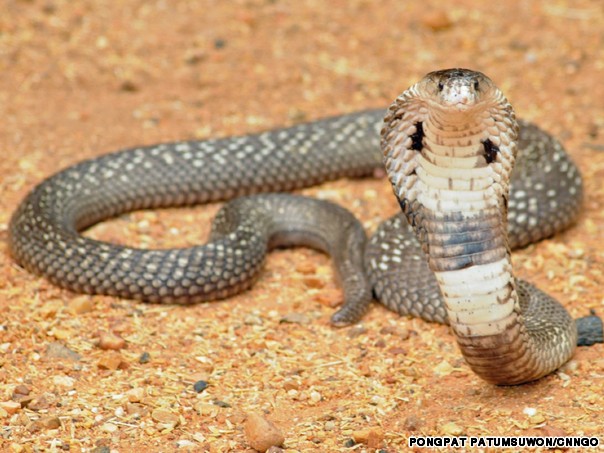
It’s difficult to feel at ease when walking around Ban Kok Sa-Nga, in Thailand’s northeast province of Khon Kaen. Despite appearances, this quiet little village is the stuff of nightmares and bad Samuel L. Jackson movie plots.
Better known among tourists as simply “The Cobra Village,” almost all of Ban Kok Sa-Nga’s 140 or so homes have at least one pet snake living in a wooden box outside, from massive king cobras and deadly monocled cobras to less dangerous species like pythons and copperheaded racers.
It all started about 60 years ago, when a local doctor decided it was time to reinvent the village and convinced his fellow villagers to start acquiring snakes for their homes and put them in shows to attract tourists.
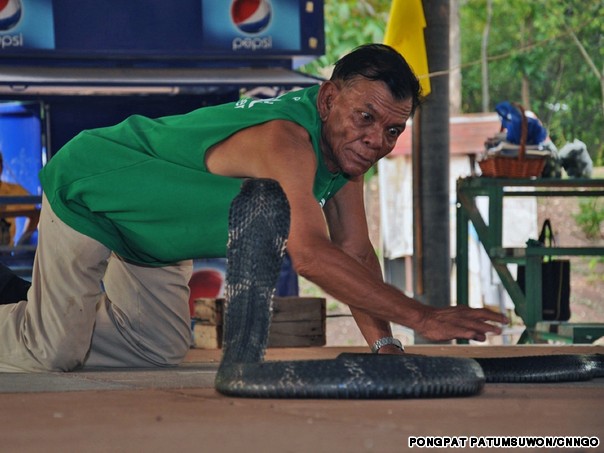
Cobra shows in Thailand are now as ubiquitous as bull fights in Mexico. And there’s nothing particularly remarkable about Ban Kok Sa-Nga’s version, with its bad sound system and exaggerated gasps of disbelief from the announcer as the showmen dodge the venomous fangs of the king cobras.
But walking around the village, away from the show grounds, what’s intriguing is how eerily comfortable all its residents are living with animals that give most people bad dreams.
‘If I didn’t get my fingers amputated, I would have died’
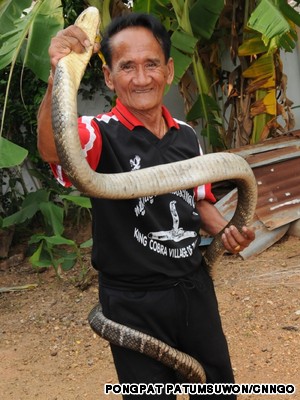
Bualee Chai, 71, is the village’s top snake handler. He’s been working with cobras for over 50 years, touring Thailand to put on snake shows in tourist hot spots like Koh Samui, Phuket and Krabi in addition to Ban Kok Sa-Nga.
“I’ve been bit 21 times,” he says with a tinge of pride in his voice, holding up his battered hands, which are absent a few digits.
“If I didn’t get my fingers amputated, I would have died. The last time I was bit and lost a finger was December 26, 2004. It was the exact moment the tsunami hit Thailand.”
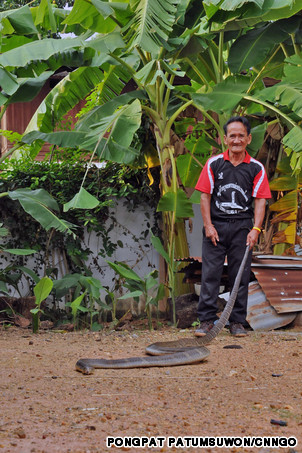
Bualee Chai says he refuses to take anti-venom when he gets bit, because the technique used to extract the venom is cruel and hurts the animals.
An ironic statement coming from a man who moments earlier could be seen, center stage, forcefully kicking a king cobra’s head to the floor in a man vs. snake ‘boxing’ match. But Bualee’s adoration for his snakes is evident when we leave the show grounds and arrive at his house, one of the largest and newest in the village.
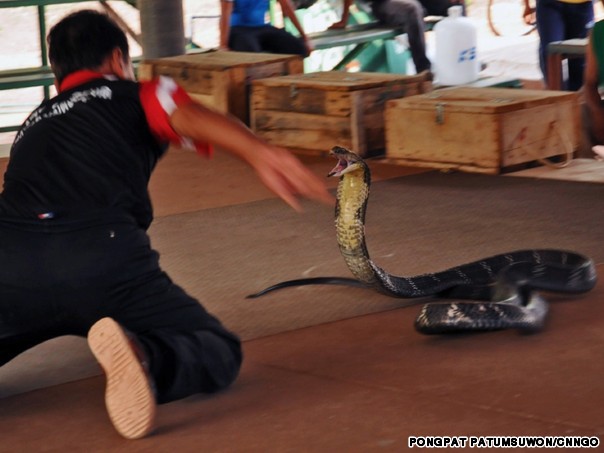
As Bualee pulls his cobras, one at a time, out of their wooden boxes, kept behind a shed next to his house, he admits that he considers them part of his family. These include a massive 40-year-old king cobra and a stunning monocled cobra that almost seems willing to pose for the camera.
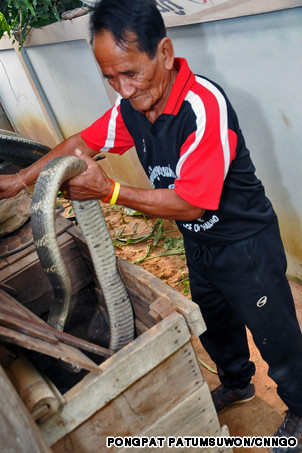
“If one of my snakes died, I would definitely be very sad,” says Bualee. “They’ve been with me for years. When snakes in our village die, we make offerings for them at the temple.”
A herb scientifically proven to fight venom
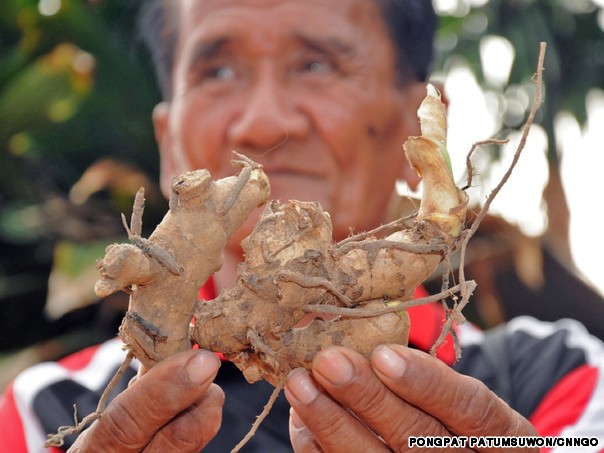
Ban Kok Sa-Nga’s residents take turns helping out at the show grounds, though they don’t make much money given admission is donation-based. Bualee says the village’s main source of cash is still locally grown herbs, sold at the cobra show market and around Khon Kaen province.
The herb Ban Kok Sa-Nga is most famous for is “wan paya ngoo,” which Bualee says they use when the snakes’ fangs manage to sink into some skin.
“It’s mixed with lime and applied to snake bikes,” he says. “But it can help heal bites from any venomous animal, such as scorpions or millipedes. If you get bit really badly, you should eat it. You’ll feel better within 30 minutes.”
A report on the U.S. National Library of Medicine website confirms wan paya ngoo is indeed effective against cobra venom, linking it to an isolated molecule that is potent enough to protect cellular proteins from the venom’s degradative enzymes.
Keeping the children safe
Though the feeling that a cobra, hood flaring, could pop out of a bush at any minute prevails, in reality the village keeps its snakes locked up securely. Unless you ask a local to see his/her personal stash, chances are the only snakes you’ll encounter are the ones in the show.
Children play freely in the streets, seemingly oblivious to the presence of the deadly creatures their families own.
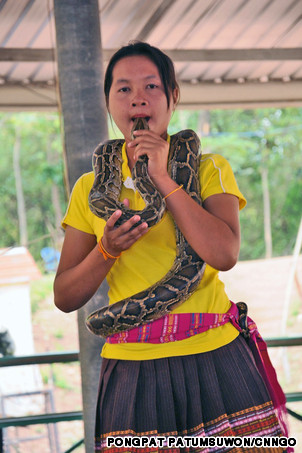
“Obviously we have to teach the kids how to handle snakes from a young age,” says Bualee. “Every detail. How to fight them, feed them. It’s up to every parent to make sure their children learn these things.”
The village doesn’t just breed snakes. Bualee says they buy them too, with people from other Isaan provinces as far away as Sisaket bringing them to Ban Kok Sa-Nga. For each snake, he says they’ll pay 5,000 to 6,000 baht. And selling them is out of the question.
So if they’re not making money off of them, why buy them?
“Because we all love snakes,” he says. “It’s not just for business. Very few of the snakes are put in the show. We just buy them to take care of them.”
Source – http://travel.cnn.com/bangkok/visit/discovering-isaan/gallery-inside-thailands-cobra-village-514756
Cobra Village in Khon Kaen
It’s difficult to feel at ease when walking around Ban Kok Sa-Nga, in Thailand’s northeast province of Khon Kaen. Despite appearances, this quiet little village is the stuff of nightmares and bad Samuel L. Jackson movie plots.
Better known among tourists as simply “The Cobra Village,” almost all of Ban Kok Sa-Nga’s 140 or so homes have at least one pet snake living in a wooden box outside, from massive king cobras and deadly monocled cobras to less dangerous species like pythons and copperheaded racers.
It all started about 60 years ago, when a local doctor decided it was time to reinvent the village and convinced his fellow villagers to start acquiring snakes for their homes and put them in shows to attract tourists.
Cobra shows in Thailand are now as ubiquitous as bull fights in Mexico. And there’s nothing particularly remarkable about Ban Kok Sa-Nga’s version, with its bad sound system and exaggerated gasps of disbelief from the announcer as the showmen dodge the venomous fangs of the king cobras.
But walking around the village, away from the show grounds, what’s intriguing is how eerily comfortable all its residents are living with animals that give most people bad dreams.
‘If I didn’t get my fingers amputated, I would have died’
Bualee Chai, 71, is the village’s top snake handler. He’s been working with cobras for over 50 years, touring Thailand to put on snake shows in tourist hot spots like Koh Samui, Phuket and Krabi in addition to Ban Kok Sa-Nga.
“I’ve been bit 21 times,” he says with a tinge of pride in his voice, holding up his battered hands, which are absent a few digits.
“If I didn’t get my fingers amputated, I would have died. The last time I was bit and lost a finger was December 26, 2004. It was the exact moment the tsunami hit Thailand.”
Bualee Chai says he refuses to take anti-venom when he gets bit, because the technique used to extract the venom is cruel and hurts the animals.
An ironic statement coming from a man who moments earlier could be seen, center stage, forcefully kicking a king cobra’s head to the floor in a man vs. snake ‘boxing’ match. But Bualee’s adoration for his snakes is evident when we leave the show grounds and arrive at his house, one of the largest and newest in the village.
As Bualee pulls his cobras, one at a time, out of their wooden boxes, kept behind a shed next to his house, he admits that he considers them part of his family. These include a massive 40-year-old king cobra and a stunning monocled cobra that almost seems willing to pose for the camera.
“If one of my snakes died, I would definitely be very sad,” says Bualee. “They’ve been with me for years. When snakes in our village die, we make offerings for them at the temple.”
A herb scientifically proven to fight venom
Ban Kok Sa-Nga’s residents take turns helping out at the show grounds, though they don’t make much money given admission is donation-based. Bualee says the village’s main source of cash is still locally grown herbs, sold at the cobra show market and around Khon Kaen province.
The herb Ban Kok Sa-Nga is most famous for is “wan paya ngoo,” which Bualee says they use when the snakes’ fangs manage to sink into some skin.
“It’s mixed with lime and applied to snake bikes,” he says. “But it can help heal bites from any venomous animal, such as scorpions or millipedes. If you get bit really badly, you should eat it. You’ll feel better within 30 minutes.”
A report on the U.S. National Library of Medicine website confirms wan paya ngoo is indeed effective against cobra venom, linking it to an isolated molecule that is potent enough to protect cellular proteins from the venom’s degradative enzymes.
Keeping the children safe
Though the feeling that a cobra, hood flaring, could pop out of a bush at any minute prevails, in reality the village keeps its snakes locked up securely. Unless you ask a local to see his/her personal stash, chances are the only snakes you’ll encounter are the ones in the show.
Children play freely in the streets, seemingly oblivious to the presence of the deadly creatures their families own.
“Obviously we have to teach the kids how to handle snakes from a young age,” says Bualee. “Every detail. How to fight them, feed them. It’s up to every parent to make sure their children learn these things.”
The village doesn’t just breed snakes. Bualee says they buy them too, with people from other Isaan provinces as far away as Sisaket bringing them to Ban Kok Sa-Nga. For each snake, he says they’ll pay 5,000 to 6,000 baht. And selling them is out of the question.
So if they’re not making money off of them, why buy them?
“Because we all love snakes,” he says. “It’s not just for business. Very few of the snakes are put in the show. We just buy them to take care of them.”
Source – http://travel.cnn.com/bangkok/visit/discovering-isaan/gallery-inside-thailands-cobra-village-514756
Little Italy in Thailand
Ever wondered how you could get out of Thailand while being in Thailand?
Look no further than the Tuscan-village-themed attraction, Palio Khao Yai, located near Khao Yai National Park, just 2 hours northeast of Bangkok.
Palio is an “Italian village” that features faux Italian architecture set in a tranquil spot amid copious greenery.
It is nestled among vineyards, dairy farms, upscale housing developments, organic Thai villages, hotel resorts, and even some Buddhist temples.
The “Italian village” features more than 100 stores and restaurants on pedestrian streets and alleyways that radiate like wheel spokes from the center, Piazza Palio.
The developers went out of their way to recreate the feeling of wandering through a small town in Tuscany, complete with a clock tower, baroque-style buildings covered in ivy, a manicured garden, and a replica of the famous Bocca della Verità (“Mouth of Truth”) carving in Rome.
References:
http://worldadventurers.wordpress.com/2012/06/18/palio-khao-yai-the-italy-of-thailand/
http://stuckinthailand.com/korat/visiting-palio-khao-yai